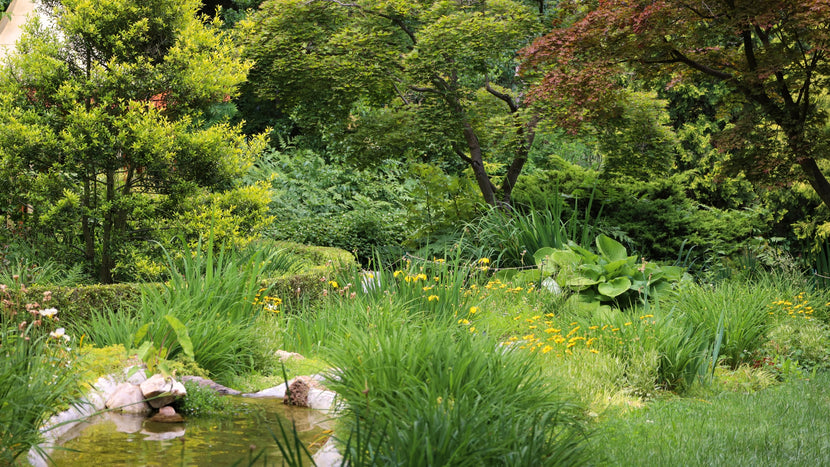
Creating a Woodland Garden Using Native Plants
Designing a woodland garden with native plants is a rewarding way to create a sustainable, low-maintenance landscape that supports local ecosystems while providing year-round beauty. Inspired by the natural landscapes of forests, Woodland gardens use layers of native trees, shrubs, perennials, and groundcovers to mimic the understory of a woodland setting.
This approach enhances the garden's aesthetic appeal and fosters biodiversity by providing food and habitat for native wildlife. Whether you have a shaded area under mature trees or are starting from scratch, incorporating native plants into your woodland garden is a surefire way to create a thriving and resilient landscape.

Why Choose Native Plants for Your Woodland Garden?
Native plants are the cornerstone of a successful woodland garden because they are adapted to local soil, climate, and wildlife. These plants have evolved over thousands of years to thrive in your region's specific conditions, making them more resistant to pests and diseases and reducing the need for chemical inputs. Additionally, native plants play a crucial role in supporting local pollinators, birds, and other wildlife by providing essential food sources and habitats.
Using native plants in your woodland garden also helps conserve water and protect soil health. Many native woodland plants are naturally adapted to shaded, moist environments and can thrive with minimal irrigation once established. Their deep root systems stabilize soil, reduce erosion, and improve soil structure, contributing to the overall health of your garden.
Key Elements of a Woodland Garden
When designing a woodland garden, it's essential to consider the different layers of the forest: the canopy, understory, and ground layer. Each layer plays a vital role in creating a balanced and diverse ecosystem.
Canopy Layer
The tallest layer in your woodland garden, the canopy is formed by native trees that cascade over your landscape and create whimsical shade for your plants to thrive in. These trees not only provide shade, but also define the garden's structure, and offer shelter for birds and other wildlife.
Understory Layer
Beneath the canopy, the understory layer is made up of smaller trees and shrubs. These plants ideally add texture and color to the garden, especially in the fall when their foliage turns brilliant shades of yellow, red, and orange.
Ground Layer
The ground layer consists of native perennials that thrive in the dappled shade of the upper layers. These plants work to create a lush carpet of foliage and flowers, adding interest and biodiversity to the garden.

Selecting Native Plants for Your Woodland Garden
When choosing native plants for your woodland garden, it's important to consider the specific conditions of your site, such as soil type, moisture levels, and light availability. Below are some recommended native plants for each layer of your woodland garden:
Canopy Layer Plants
- Oak Trees (Quercus spp.)
- Maple Trees (Acer ssp.)
- Dunstan Chestnut Trees (Castanea dentata 'Dunstan')
Understory Layer Plants
- American Witch Hazel (Hamamelis virginiana)
- Red Chokeberry (Aronia arbutifolia)
- Fothergilla 'Mt. Airy'
Ground Layer Plants
- Coral Bells (Heuchera)
- Virginia Bluebells (Mertensia virginica)
- Wild Geranium (Geranium maculatum)
- Ferns (Dryopteris spp., Polystichum acrostichoides)

Benefits of a Woodland Garden
Creating a woodland garden with native plants offers numerous benefits beyond its natural beauty. By mimicking the layers and diversity of a forest, you create a landscape that is more resilient to climate change and environmental stressors.
Native woodland gardens also require less maintenance and fewer resources, such as water and fertilizers, making them eco-friendly for homeowners looking to reduce their environmental footprint.
Additionally, woodland gardens provide critical habitat for native wildlife, supporting biodiversity in your local area. Birds, butterflies, bees, and other pollinators are drawn to the rich variety of plants, creating a thriving ecosystem right in your backyard.
Conclusion
A woodland garden filled with native plants is more than just a beautiful landscape; it's a sustainable and environmentally responsible way to enhance your property. By selecting native trees, shrubs, and perennials that thrive in your local climate, you can create a garden that is not only visually stunning but also beneficial to the environment.
Whether you're starting with a shaded area or planning a new garden, embracing the principles of woodland gardening with native plants is a fulfilling way to connect with nature and support local ecosystems. Start your woodland garden today and experience the joy of watching a thriving, biodiverse landscape unfold in your own backyard.
